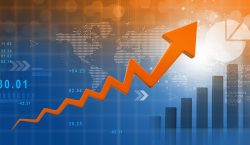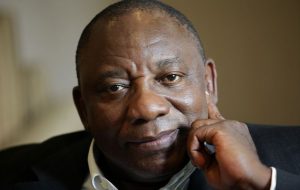

South Africa’s economic hole is so deep that it will take a long time to climb out of it. And Eskom remains a key obstacle to, and indicator of, its progress.

Cyril Ramaphosa, President of South Africa.
First, recall the sheer scale of the destruction likely wrought in the second quarter of 2020, which began days after the start of the hard lockdown and ended with the economy gradually rebooting but with wide swathes still at a standstill.
The estimates are numbing, and make the recession that preceded it almost resemble a lost era of prosperity in hindsight. (Note: load shedding was a thing then too).
“Overall, we think that GDP probably contracted by 22 percent q/q in Q2 (and 63 percent q/q on an annualised basis), one of the largest falls in output anywhere in the world. Some sectors — most notably hospitality services and construction — have probably seen even sharper falls in output than 20-30 percent q/q declines suffered by the manufacturing and retail sectors,” Capital Economics said in a recent research note.
Investec said in a note last week that it was forecasting a Q2 shrinkage of 48 percent but noted that incoming data suggested it could reach 60 percent on an annualised basis. (By the way, to “annualise” generally means converting a short-term calculation — in this case four months — into the same rate over a full year.)
So the crater created by the Covid-19 asteroid is massive.
But even extinction-level events are followed by fresh stirrings of new life. In South Africa, that became apparent in July, two months after the mining sector began its reboot and as other parts of the economy slowly reopened. That was when Eskom brought back the load shedding, which had not been implemented since before the hard lockdown was imposed on March 27.
Rising power demand was partly related to the fact that it was winter but also stemmed from increased economic activity.
And there have been other signs of tepid third-quarter recovery. Lombard Odier, a private Swiss bank, using its proprietary process and models of big data, said that as of August 9, South Africa had recovered 77 percent of its pre-Covid-19 economic activity, compared to the 2017-19 average.
“We watch eight high-frequency signals: import and exports, city congestion levels, mobility data, retail and grocery consumption, workplace presence and air pollution levels for production. Taken together, they can give us a picture of the state of an economy’s recovery,” Stéphane Monier, Lombard Odier’s chief investment officer, said.
Such big data measurements can give a more current snapshot for investors than government data, which often has a one-month lag or more. Stats SA’s official assessment of the Q2 GDP performance only comes out next month and the current Q3 won’t be published before December.
“The challenge for investors is to gauge progress toward ‘normalisation’ in comparison with historic levels of supply and demand. As a result, this pandemic is turning into the most powerful test yet for the value of data science. The right data sets can help us to improve our real-time diagnosis of the recovery and market trends.
“That means that it can also help us as we make investment decisions and construct portfolios. Before we can include a data set in our investment analysis, we compare it with other indicators to ensure that their insights are adding value to our forecasts.
“We can then use this to fill the gap between official government numbers, which often reports statistics with a lag of a month or more,” Monier said. — DM/BM